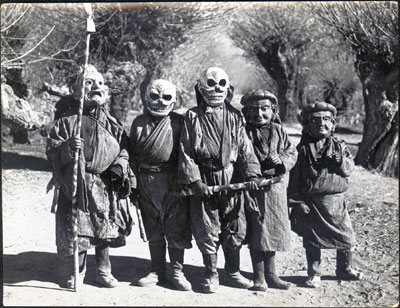
2001.35.356.1 (Print Black & White)


2001.35.356.1 (Print Black & White)

Frederick Spencer Chapman
Evan Yorke Nepean
December 1st 1936
Lhasa > Dekyi Lingka
2001.35.356.1
106 x 80 mm
Print silver
Loaned August 2002
Judy Goldthorp
British Diplomatic Mission to Lhasa 1936-37
Lady Nepean
C.15.12 In publication
'Lhasa Mission 1936, Diary of Events', P. Neame, H. Richardson, F. S. Chapman, Government of India Political Department [Note: photographs for October 18th - November 4th 1936 are not included as their relationship to text is not detailed; see Mission Diary text for details of images] [see photos in publication]
'Lhasa Mission 1936, Diary of Events', P. Neame, H. Richardson, F. S. Chapman, Government of India Political Department [Note: photographs for October 18th - November 4th 1936 are not included as their relationship to text is not detailed; see Mission Diary text for details of images] [view list of illustrations]
Notes on print/mount - 'Devil dancers'; [ink no:] 113; [pencil no:] C-15/12 ; [blue no:] '; from an envelope marked 'Chang Girls, Fat Monks, Dancing Girls, Mummers' [KC 14/08/2006]
Manual Catalogues - Caption in Chapman's hand-written list of negatives made whilst on the Mission to Lhasa, 1936-7 [See PRM Manuscripts Collection]: 'Mummers - Group of 5' [MS 14/08/2006]
Other Information - Related Images: Images prefixed with 'C.15' taken on the British Mission to Lhasa in 1936-37 comprise a group of negatives containing images of threshing barley, Regent’s house, ferry near Dekyi Lingka and panoramic views of environs, mummers, Norbu Lingka, paper chase, tea at football match, Everest permit, Kampa people. This collection of images is headed with the title of ‘Rural Pursuits’ and it seems that Chapman may originally have intended to use this box of negatives whilst seeking out scenes such as threshing barley. However, this objective seems to have passed as the box was used as a wider variety of images than this were taken subsequently. This may also reflect the limitations of access to such scenes in and around the mission compound in the Dekyi Lingka and the constraints upon the photographic agenda of the mission. They seem all to have been taken between November 27th 1936 - January 7th 1937 [MS 14/08/2006]
Other Information - Description: Chapman describes in the official Diary of the British Mission to Lhasa for the day of December 1st 1936 how this troupe of Lhasa mummers visited the Dekyi Lingka. He wrote in the entry for this date: "Some mummers came and danced for our entertainment. These are local performers as opposed to the more accomplished Khamba dancers and acrobats who tour the countryside professionally". See 1998.131.555/556/557 for images of the Khampa troupe. Chapman went on to describe the Lhasa mummers more fully in his published account of the Mission, Lhasa the Holy City [London: Chatto & Windus, 1938; reprint, London: Readers Union Ltd., 1940]. He wrote: "Another troupe that visited us was the Lhasa mummers. These were local artisans and farm labourers who occasionally spend an afternoon in this manner. There were eight men in all. One pair wore extremely skilfully made masks of bright green papier mache; another couple wore skeleton masks, while the third held a long striped stick and wore a mask with a vacant melancholy expression. The other three comprised the band - two with large drums, each supported by a handle, while the third played cymbals. // Various dances were performed in which the actors stepped solemnly round each other, made gestures with their arms and bowed, as they endeavoured to act traditional stories which seemed to be well known to the Tibetans. // Dancing, except when performed by the monks, is considered a very low caste occupation, and all the performers, both Khampas and mummers, seemed to be very poor" [1940, p.273] [MS 26/3/2005]
For Citation use:
The Tibet Album.
"Mummers at Dekyi Lingka"
05 Dec. 2006. The Pitt Rivers Museum.
<http://tibet.prm.ox.ac.uk/photo_2001.35.356.1.html>.
For more information about photographic usage or to order prints, please visit the The Pitt Rivers Museum.
© The Pitt Rivers Museum